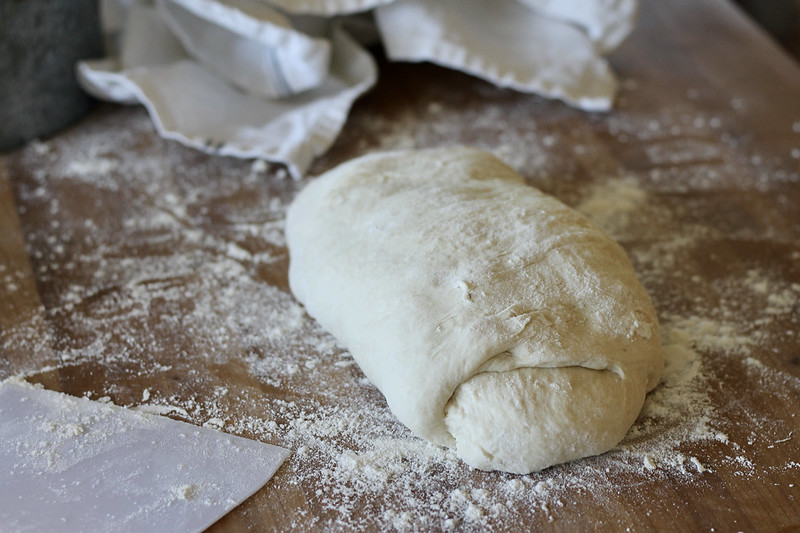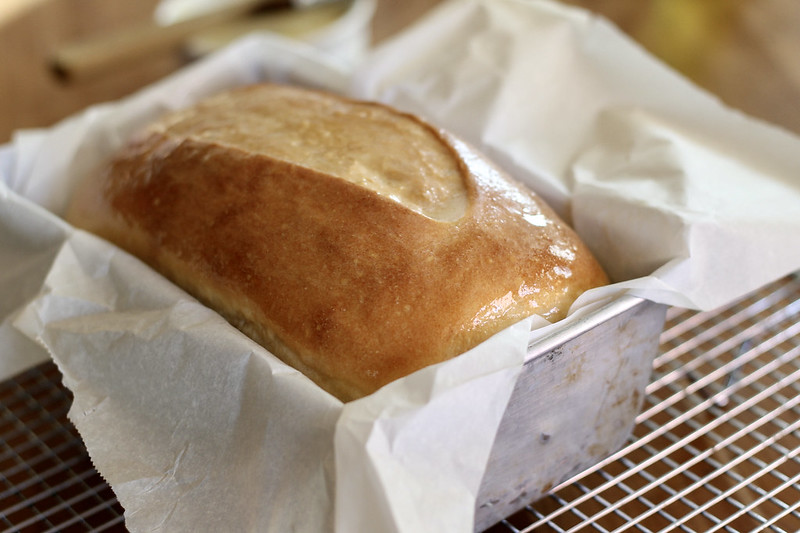Know this: I was not after a soft sourdough recipe. I love our bakery sourdough, and I love my homemade sourdough. But when one of you pointed me in the direction of Kate of Venison for Dinner (because of all her milk and cheese posts which have been awesome, by the way— thank you!), I couldn’t help noticing she had this soft sourdough recipe that kept popping up in her posts, and I became curious. According to Kate, she uses this recipe for everything from buns to loaves to cinnamon rolls.
Why soft sourdough instead of the regular fabulous stuff, you ask? Well, some people, apparently, take issue with sourdough bread’s crustiness. This, I think, is weird — the crunchy, chewy crust is half the fun, right? — but I do get it that for anyone with tender teeth or weak jaws, a hard crust could be an inconvenience. Plus, some people just prefer billowy, soft bread without a sour tang.
Like I said, weird.
But, since I have a raging case of FOMOOF (Fear Of Missing Out Of Food), of course I had to try it— and it was totally different from any sourdough I’d ever made!



In fact, my family thought I was lying when I said it was sourdough. “Nah,” they said, “this is more like Wonder Bread,” a comment which, I suppose, could be seen as offensive, but I happened to agree. It was so soft and white and non-tangy that I actually made myself a peanut butter and jelly sandwich with the fresh bread, the first PB&J I’d made in years, probably, and it was divine.

Even though the bread is fully sourdough (which I still kinda can’t believe), it’s incredibly tender with just the gentlest bit of chew and only the faintest hint of sourness. And the loaves are so soft, they’re squeezable. Each time I pick one up, I think of babies’ butts.
But wait! It gets better! Because then I decided to try making cinnamon rolls with the dough.

Since subbing ordinary bread dough for cinnamon roll dough has never failed to be anything but a crushing disappointment — the rolls always seem to end up tasting like bread trying to be something it’s not — I was deeply skeptical. But they turned out wonderful: caramelly and soft and chewy.

My husband says he much prefers this version to my regular potato-based dough which, he says, is too soft and sweet. This one has a little more heft, and it’s less sweet, so it feels more real. (Sweetness with a spine. Like me.) Normally, he eats one cinnamon bun and is done. With these, he couldn’t stop.

at night: my starter, my baby
The process for this bread is simple but, since it stretches over two days, I recommend jotting down a schedule for the first couple times, just so you know what happens when and don’t have to think about it much.

in the morning: double-batch of levain, ready to go
While you can do these steps at different times so that you end up with fresh bread whenever you want it, for simplicity’s sake, my method goes like so: in the evening, make the levain; in the morning, make the dough, let it rise for two hours, punch it down, let it rise for another two hours, shape into loaves, buns, whatever, let it rise for two hours, bake. (For variations on the scheduling theme, see Kate’s post.)

baby butt-soft whole wheat sourdough buns
As for ingredients, I’m still messing around with flours. I wonder if a higher-gluten flour may yield a chewier bread? When I want whole wheat, I use coarsely ground whole wheat in place of the AP flour for the levain (so far, using whole wheat in the main dough has resulted in a bread that’s too heavy) and then proceed as normal with the actual bread dough ingredients.

soft whole wheat sourdough

However, I think the all-purpose flour may be key to making a soft bread so I recommend starting with that and then branching out.

Soft Sourdough Bread
Adapted from Kate of Venison for Dinner.
In place of butter, use coconut oil, lard, olive oil. Though I haven’t tried it yet, Kate says you can sub eggs for the milk — 1 egg for a quarter cup of milk.
Note: brushing butter all over the top after it’s done baking and then letting it cool in the bread pan are both key in getting a soft bread. Do not skip this step.
I almost always double the amounts.
evening levain:
½ cup cool water
½ cup sourdough starter
⅔ cups all-purpose flour
Stir together, cover, and let set at room temperature overnight.
morning dough:
1 tablespoon butter, melted
1 tablespoon honey
¾ cups milk
the levain
2 teaspoons salt
2½ cups all-purpose flour, plus more
Melt the butter and stir in the honey. Add the milk. Pour the liquids into the bowl of your stand mixer (they should be only slightly warm), and add the levain, salt, and flour. Mix until combined and then let sit for 20-30 minutes. (I’ve actually been skipping this step, but I think I oughta do it.) Using the dough hook, mix (or, if by hand, knead) for a long time — like 8-10 minutes. Cover and let rise until double, about 2-3 hours. Punch down. Let rise another 2-3 hours.
Turn the dough out on a floured counter. Pat into a rectangle and fold into thirds, as though folding a business letter. Place seam side down on the counter and rest for ten minutes. (If making cinnamon rolls, here’s where you roll the dough into a rectangle and then fill, roll, and cut as per any other recipe. Or, if making buns, same thing — shape and proceed.) Pat the dough into a rectangle — or circle or triangle or whatever — and then roll into a loaf shape, tucking in the ends as you go. This sounds complicated but is really easy. Just do it. Place seam side down into a greased bread tin. Let rise for another 2-3 hours.
Slash the top of the loaf and bake at 375 degrees for 30-40 minutes, rotating halfway through, until golden brown and the internal temp is 190-195 degrees. Remove the pan from the oven and brush butter all over the top. Let the loaf cool for at least 20-30 minutes in the pan before turning out on a rack. Both the additional butter and the cooling in the pan are key to getting a soft loaf.
This same time, years previous: another farm, another job, impressing us, three feet, field work, the reading week, autumn walk, a pie party!, moments of silence.
7 Comments
kay BOUMA
Do you have a recipe for the whole wheat loaf soft or
buns yet?
Jennifer Jo
No recipe exactly, but you can just use whole wheat flour instead of AP flour in the evening levain for a more wholegrain loaf. (And if you want an even more wheaty loaf, then sub whole wheat in place of the AP flour in the morning mix — the resulting bread will be heavier and more dense, though, just fyi…)
Ari Marquez
Is overnight 8 hrs? Is the starter aupossed to be active and bubbly in the morning? I ask cuz if its warm….I could miss the bubbly point.
Thanks!
Jennifer Jo
Yes, overnight is 8-12 hours. If your house is between 60-70-ish degrees, room temp is fine. Any warmer than that and you may want to pop it into a cooler with a couple ice packs for its overnight rest.
Lauralli
Have you ever made/kept/used an old fashioned starter that is liquid and made with instant potato flakes? It’s the only kind of starter I’ve used. It makes a soft and pretty sweet sourdough bread. It’s so easy and very forgiving even when I neglect it for 2-3 weeks in the fridge. Makes the best cinnamon rolls!
Jennifer Jo
I have not tried that type of starter (at least not that I can remember), but potatoes (mashed and/or the water from cooking) are awesome in bread dough.
Elva
This looks delicious!